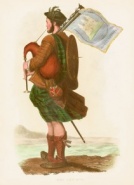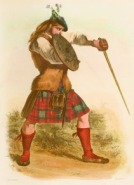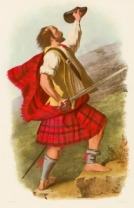McIan's
Highlanders
 Robert
Ronald McIan. From The Clans of The Scottish Highlands. London:
Ackermann and Co., 1845. Folio; ca. 12 x 8. Lithographs. Original
hand-colour. Robert
Ronald McIan. From The Clans of The Scottish Highlands. London:
Ackermann and Co., 1845. Folio; ca. 12 x 8. Lithographs. Original
hand-colour.
A
series of beautiful hand-colored prints of the highland clans
from Scotland, showing the clan tartans. Queen Victoria was the
first of the English monarchs to become interested in her Scottish
heritage. In response to this royal interest, R. R. McIan and
James Logan made extensive research into the clans of the Scottish
highlands, and then produced their sumptuous volumes.
This was the first comprehensive illustrated work on the Scottish
clans, presenting a descriptive history of each clan and a picture
of its clan plaid. Thus, these images represent a primary source
for subsequent work on the clans and their tartans. These are
fascinating and colorful pieces of Scottish history.
 R
R McIan was born in Scotland 1803. His initial passion was for
acting and in his late teens moved to London to join the Covent
Garden Theatre. His extrovert character fitted in well with the
stage and London life in the 1830s and it was during this period
that he explored and developed his second passion - painting. R
R McIan was born in Scotland 1803. His initial passion was for
acting and in his late teens moved to London to join the Covent
Garden Theatre. His extrovert character fitted in well with the
stage and London life in the 1830s and it was during this period
that he explored and developed his second passion - painting.
His first work to be submitted to the Royal Academy of Painting
in London was in 1835 and was followed by a series of paintings
depicting events and scenes of drama and conflict from Scotland's
history - The Battle of Culloden, A Highland Feud and many others.
In the early 1840s, encouraged by the favourable reception of
his work, he left the stage to concentrate on painting. A fortuitous
meeting with James Logan resulted in a collaboration - The Clans
of the Scottish Highlands - Logan writing the text and McIan the
illustrations.
 "The
Costumes of the Clans of Scotland" - the book's working title
- was issued to commemorate the centenary of the 1745 uprising
and was available on subscription only. It was dedicated to Queen
Victoria, with her consent, and reflected the great interest in
all things Scottish prevalent in London and the USA at the time. "The
Costumes of the Clans of Scotland" - the book's working title
- was issued to commemorate the centenary of the 1745 uprising
and was available on subscription only. It was dedicated to Queen
Victoria, with her consent, and reflected the great interest in
all things Scottish prevalent in London and the USA at the time.
It is reputed that the models McIan used were actor friends seconded
for the purpose. There has been much debate as to the accuracy
of McIan's work - in terms of dress, the tartan patterns, etc,
and it is generally accepted that a degree of artistic licence
was exercised by McIan in his interpretations. There is little
doubt that his depictions reflected the then popular romanticised
view of Scotland.
McIan and Logan continued to collaborate producing a further volume
- THE HIGHLANDERS AT HOME in 1848. McIan was happily married to
Fanny - an accomplished artist in her own right and continued
to paint until his death in 1856 - the result of a wasting disease.
He leaves as a legacy some of the most enduring images of Scotland
ever produced.
|
